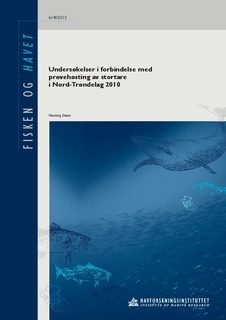| dc.description.abstract | The Institute of Marine Research surveyed the kelp vegetation, before and after the first ever kelp (Laminaria hyperborea) harvesting in Nord-Trøndelag in September 2010. Survey stations included both kelp harvested areas and nearby reference areas, and was performed by underwater video. In addition, kelp plants were collected for measurements of plant length, weight and age. Based on these observations the state of the kelp forest was consicered to be healthy, with large and dense kelp vegetation, and moderate densities of sea urchins, across most of the surveyed area. Echinus esculentus was the dominant sea urchin, and only a couple of juvenile Strongylocentrotus droebachiensis was observed. The average percentage of kelp harvested was estimated to be around 2,2% of standing kelp stock, above 20 meters depth. There was a considerable amount of small kelp plants left behind after harvest, whose role in restoration of the kelp vegetation may prove vital. No reduction in fish abundance was observed after kelp harvesting. | en_US |
